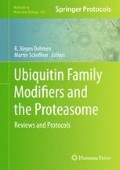Abstract
The maintenance of proteostasis is a fundamental process that encompasses refolding and degradation of unfolded and damaged proteins to enable organismal development (1). In eukaryotic cells, the ubiquitin/proteasome system (UPS) is a key determinant of proteostasis by regulating protein turnover. During the past decade, detailed mechanistic insight about the UPS was revealed from extensive studies in mono-cellular systems, such as yeast or tissue culture cells. However, a further challenge is to decipher how ubiquitin-dependent degradation pathways promote cellular differentiation and development of multicellular organisms. In this chapter, we describe an in vivo assay to study protein turnover during development and in differentiated tissues in response to intrinsic and environmental challenges in the multicellular organism Caenorhabditis elegans. This assay is particularly suitable to perform large-scale genetic screens for the identification of novel proteolysis factors and pathways important for developmental processes and opens new avenues for future investigation of tissue- or development-specific proteostasis networks.
Access this chapter
Tax calculation will be finalised at checkout
Purchases are for personal use only
References
Powers ET, Morimoto RI, Dillin A et al (2009) Biological and chemical approaches to diseases of proteostasis deficiency. Annu Rev Biochem 78:959–991.
Ciechanover A, Orian A, Schwartz AL (2000) Ubiquitin-mediated proteolysis: biological regulation via destruction. Bioessays 22:442–451.
Kerscher O, Felberbaum R, Hochstrasser M (2006) Modification of proteins by ubiquitin and ubiquitin-like proteins. Annu Rev Cell Dev Biol 22:159–180.
Hoppe T (2005) Multiubiquitylation by E4 enzymes: ‘one size’ doesn’t fit all. Trends Biochem Sci 30:183–187.
Koegl M, Hoppe T, Schlenker S et al (1999) A novel ubiquitination factor, E4, is involved in multiubiquitin chain assembly. Cell 96:635–644.
Johnson ES, Ma PC, Ota IM, Varshavsky A (1995) A proteolytic pathway that recognizes ubiquitin as a degradation signal. J Biol Chem 270:17442–17456.
Richly H, Rape M, Braun S et al (2005) A series of ubiquitin binding factors connects CDC48/p97 to substrate multiubiquitylation and proteasomal targeting. Cell 120:73–84.
Jentsch S, Rumpf S (2007) Cdc48 (p97): a “molecular gearbox” in the ubiquitin pathway? Trends Biochem Sci 32:6–11.
Rape M, Hoppe T, Gorr I et al (2001) Mobilization of processed, membrane-tethered SPT23 transcription factor by CDC48(UFD1/NPL4), a ubiquitin-selective chaperone. Cell 107:667–677.
Bays NW, Gardner RG, Seelig LP et al (2001) Hrd1p/Der3p is a membrane-anchored ubiquitin ligase required for ER-associated degradation. Nat Cell Biol 3:24–29.
Braun S, Matuschewski K, Rape M et al (2002) Role of the ubiquitin-selective CDC48(UFD1/NPL4) chaperone (segregase) in ERAD of OLE1 and other substrates. EMBO J 21:615–621.
Jarosch E, Taxis C, Volkwein C et al (2002) Protein dislocation from the ER requires polyubiquitination and the AAA-ATPase Cdc48. Nat Cell Biol 4:134–139.
Ye Y, Meyer HH, Rapoport TA (2001) The AAA ATPase Cdc48/p97 and its partners transport proteins from the ER into the cytosol. Nature 414:652–656.
Ye Y, Meyer HH, Rapoport TA (2003) Function of the p97-Ufd1-Npl4 complex in retrotranslocation from the ER to the cytosol: dual recognition of nonubiquitinated polypeptide segments and polyubiquitin chains. J Cell Biol 162:71–84.
Johnson ES, Bartel B, Seufert W, Varshavsky A (1992) Ubiquitin as a degradation signal. EMBO J 11:497–505.
Bachmair A, Finley D, Varshavsky A (1986) In vivo half-life of a protein is a function of its amino-terminal residue. Science 234:179–186.
Varshavsky A (1992) The N-end rule. Cell 69:725–735.
Praitis V, Casey E, Collar D, Austin J (2001) Creation of low-copy integrated transgenic lines in Caenorhabditis elegans. Genetics 157:1217–1226.
Kamath RS, Martinez-Campos M, Zipperlen P et al (2001) Effectiveness of specific RNA-mediated interference through ingested double-stranded RNA in Caenorhabditis elegans. Genome Biol 2:RESEARCH0002.
Timmons L, Court DL, Fire A (2001) Ingestion of bacterially expressed dsRNAs can produce specific and potent genetic interference in Caenorhabditis elegans. Gene 263:103–112.
Boulin T, Etchberger JF, Hobert O. (April 5, 2006) Reporter gene fusions in WormBook, ed., The C. elegans Research Community, WormBook,doi/10.1895/wormbook.1.106.1.
Calixto A, Chelur D, Topalidou I et al (2010) Enhanced neuronal RNAi in C. elegans using SID-1. Nat Methods 7:554–559.
Schmitz C, Kinge P, Hutter H (2007) Axon guidance genes identified in a large-scale RNAi screen using the RNAi-hypersensitive Caenorhabditis elegans strain nre-1(hd20) lin-15b(hd126). Proc Natl Acad Sci U S A 104:834–839.
Simmer F, Tijsterman M, Parrish S et al (2002) Loss of the putative RNA-directed RNA polymerase RRF-3 makes C. elegans hypersensitive to RNAi. Curr Biol 12:1317–1319.
Rothbauer U, Zolghadr K, Muyldermans S et al (2008) A versatile nanotrap for biochemical and functional studies with fluorescent fusion proteins. Mol Cell Proteomics 7:282–289.
Doitsidou M, Flames N, Lee AC et al (2008) Automated screening for mutants affecting dopaminergic-neuron specification in C. elegans. Nat Methods 5:869–872.
Sarin S, Prabhu S, O’Meara MM et al (2008) Caenorhabditis elegans mutant allele identification by whole-genome sequencing. Nat Methods 5:865–867.
Segref A, Torres S, Hoppe T (2011) A Screenable in vivo Assay to Study Proteostasis Networks in Caenorhabditis elegans. Genetics 187:1235–1240.
Acknowledgments
We thank the Caenorhabditis Genetics Center (funded by the NIH National Center for Research Resources) for strains. This work was supported by grants from the European Community Network of Excellence RUBICON (LSHC-CT-2005-018683 to T.H.), the Deutsche Forschungsgemeinschaft (CECAD, FOR885, SFB635, HO2541/1-1, and HO2541/4-1 to T.H.). T.H. is an EMBO Young Investigator.
Author information
Authors and Affiliations
Corresponding author
Editor information
Editors and Affiliations
Rights and permissions
Copyright information
© 2012 Springer Science+Business Media, LLC
About this protocol
Cite this protocol
Segref, A., Hoppe, T. (2012). Analysis of Ubiquitin-Dependent Proteolysis in Caenorhabditis elegans . In: Dohmen, R., Scheffner, M. (eds) Ubiquitin Family Modifiers and the Proteasome. Methods in Molecular Biology, vol 832. Humana Press. https://doi.org/10.1007/978-1-61779-474-2_38
Download citation
DOI: https://doi.org/10.1007/978-1-61779-474-2_38
Published:
Publisher Name: Humana Press
Print ISBN: 978-1-61779-473-5
Online ISBN: 978-1-61779-474-2
eBook Packages: Springer Protocols

